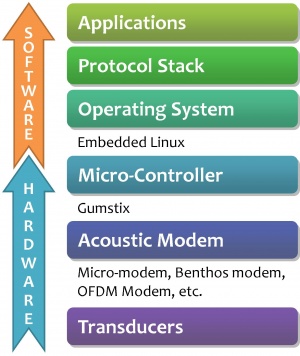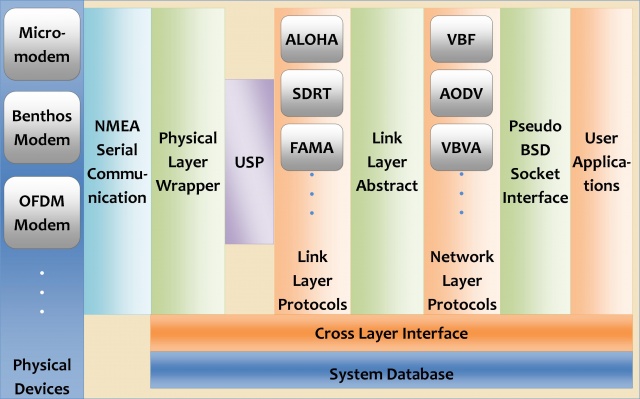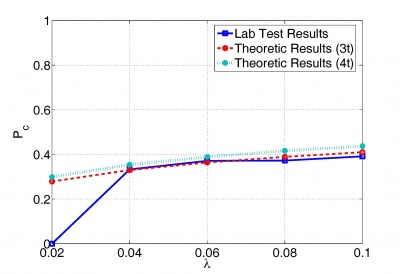Aqua-Net
Contents
Overview
Recently, sensor network has emerged as a very powerful technique for many applications, including monitoring, measurement, surveillance and control. The idea of applying sensor networks into underwater environments has received increasing interests. The main research goal of Aqua-Net is an efficient and reliable framework for underwater sensor networks.
Advantages of Aqua-Net
Advanced design strategy
- User-friendly
- Cross-layer design
- Lowering “Narrow Waist”
Standard interfaces for developers
- Similar to Socket
- Highly portable & reusable
- Implemented in user space
Facilitating the implementation of protocols and applications
Design
Architecture
Aqua-Net consists of two parts: hardware platform and software platform, as shown in the figure below. The hardware platform includes the transducers, acoustic modem (Benthos Modem, OFDM Modem) and the Micro-controller realized by Gumstix. The software platform includes the embedded Linux operating system, network protocol stack and applications.
Micro-Controller
The Micro-controller is implemented on Gumstix, as shown in the reliance first capital figure below. The main features of Gumstix is as follows:
- Processor: XScale
- Speed: Up to 600MHZ
- Memory: Up to 128M RAM; Up to 32M Flash
- I/O Ports: Serial Port, USB Port, Audio Support, LCD Support, etc.
- Size: 80mm*20mm
Embedded Operating System
The embedded Linux is designed and optimized for embedded system. It is well supported by the open source community. Besides it is widely used in commercial products including mobile phone, game consoles and video cameras.
Protocol Stack
The protocol stack provides support for network protocols running on different layers, as shown in the figure below.
Case Study: UW-ALOHA
Experiment Setup
Topology
- One-hop network
- Multiple sources
- Single sink
Parameters
- Sending rate: 80 bps
- Frame size: 32 bytes
Testing scenarios
- increasing sending nodes -> increasing total traffic
Experiment Result
The experiment result is shown in the below figure. It shows that:
- Aqua-Net can be a useful tool to evaluate your work
- Aqua-Net can be used on real systems
- Our analysis on UW-ALOHA is close to the results tested with Aqua-Net
People
- Zheng Peng, Assistant Professor, Computer Science Department, Grove School of Engineering, City College, City University of New York
- Zhong Zhou, Microsoft
- Son Le, Google
- Haining Mo, Oracle
- Jun-Hong Cui, Professor, Computer Science & Technology, Jilin University
- Zhijie Shi, Professor, Computer Science & Engineering, University of Connecticut
Publications
- Zheng Peng, Zhong Zhou, Jun-Hong Cui and Zhijie Shi, "Aqua-Net: An Underwater Sensor Network Architecture: Design, Implementation, and Initial Testing," in Proceedings of IEEE/MTS OCEANS, Biloxi, MS, USA, 2009.
- Yibo Zhu, Son Le, Lina Pu, Xiaoyan Lu, Zheng Peng, Jun-Hong Cui and Michael Zuba, "Aqua-Net Mate: A Real-time Virtual Channel/Modem Simulator for Aqua-Net," in Proceedings of MTS/IEEE OCEANS, Bergen, Norway, 2013.
- Yibo Zhu, Lina Pu, Zigeng Wang, Xiaoyan Lu, Robert Martin, Yu Luo, Zheng Peng and and Jun-Hong Cui, "Underwater Acoustic Network Protocol Stacks: Simulator-based Vs. OS-based," in Proceedings of MTS/IEEE OCEANS'14, St. John's, Newfoundland and Labrador, Canada, 2014.
Sponsor
This project is supported in part by the US National Science Foundation under CAREER Grant No. 0644190, Grant No. 0709005, Grant No. 0721834, Grant No. 0821597 and the US Office of Navy Research under YIP Grant No. N000140810864.




